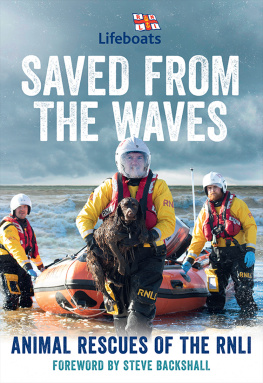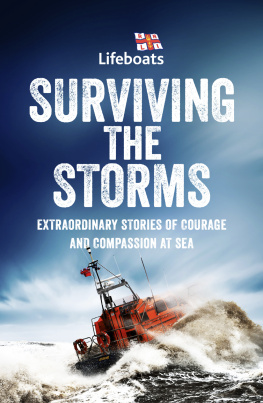Pagebreaks of the print version

Heroes of the RNLI
Heroes of the RNLI
The Storm Warriors
Martyn Beardsley
An imprint of
Pen & Sword Books Ltd
Yorkshire Philadelphia
Copyright Martyn Beardsley 2020
ISBN 978 1 52672 576 9
ePUB ISBN 978 1 52672 577 6
Mobi ISBN 978 1 52672 578 3
The right of Martyn Beardsley to be identified as Author of this work has been asserted by him in accordance with the Copyright, Designs and Patents Act 1988.
A CIP catalogue record for this book is available from the British Library.
All rights reserved. No part of this book may be reproduced or transmitted in any form or by any means, electronic or mechanical including photocopying, recording or by any information storage and retrieval system, without permission from the Publisher in writing.
Pen & Sword Books Limited incorporates the imprints of Atlas, Archaeology, Aviation, Discovery, Family History, Fiction, History, Maritime, Military, Military Classics, Politics, Select, Transport, True Crime, Air World, Frontline Publishing, Leo Cooper, Remember When, Seaforth Publishing, The Praetorian Press, Wharncliffe Local History, Wharncliffe Transport, Wharncliffe True Crime and White Owl.
For a complete list of Pen & Sword titles please contact
PEN & SWORD BOOKS LIMITED
47 Church Street, Barnsley, South Yorkshire, S70 2AS, England
E-mail:
Website: www.pen-and-sword.co.uk
Or
PEN AND SWORD BOOKS
1950 Lawrence Rd, Havertown, PA 19083, USA
E-mail:
Website: www.penandswordbooks.com
Acknowledgements
I am shamefully bad at keeping records of those whose help I have benefitted from during the lengthy process of putting a book together, so I apologise in advance to anyone whose name I have missed from the following list. I would like to thank my editor, Ting Baker, and all at Pen & Sword for their help and encouragement; Patrick Boyle, descendant of the two men of that name involved in the Stolwijk story; Nicholas Leach of the Lifeboats Enthusiasts Facebook page who helped with finding pictures; John Harper and the Grace Darling Society for advice and an interesting discussion regarding where Grace lived and died in Bamburgh; Lesley Crow, Sheila Harrison and all at the Newbiggin Maritime Centre; and especially Jeanette Hensby, for her invaluable help with the research and general moral support.
All images from Wikimedia Commons, unless otherwise stated.
Introduction
T he Royal National Lifeboat Institution has to be one of the most undervalued and taken for granted organisations in the country. If there is an emergency around the coasts of Britain and Ireland, we know that those familiar bright orange, hitech boats will soon be racing to the scene. I suspect many people assume that such a large, professional and well-equipped organisation must be government-funded, but, of course, this isnt so as those of us old enough to remember the Blue Peter appeals will appreciate! The body was founded nearly 200 years ago (as the Royal National Institution for the Preservation of Life from Shipwrecks) with money from public subscriptions, and has continued to be reliant on donations ever since. Even I had to keep reminding myself after writing about another dangerous, gruelling exploit that these men were volunteers who took time out from their real jobs and risked their lives for others in the worst possible conditions for no payment.
What became the RNLI was originally run on a fairly informal basis, without specialised boats or equipment in fact, as we shall see when we look at the Grace Darling story, there were times when volunteers preferred to take out their own sturdy vessels rather than risk putting to sea in the boat they had been provided with.
The idea of bestowing medals for gallantry stems back right to the beginnings of RNLI: initially gold and silver, with the bronze being instituted much later. It has to be said that when it comes to awarding gold medals, there has always been a bias towards coxswains and rank in general (many early recipients were naval officers employed by the coastguard). In one way this makes sense awarding golds to every person involved in a rescue could increase the numbers issued by as much as tenfold and devalue its prestige, at least in a numerical sense. As it is, under the system that has always obtained, RNLI gold medals are quite rare; it is often said to be the lifeboat version of the Victoria Cross but harder to win, on the basis that fewer have been awarded. But still, there are cases, such as the engineer of the City of Bradford II during the Gurth rescue, who as we shall see stayed at his post while almost up to his neck in icy seawater, working the lifeboats controls with numb fingers by feel alone, where the awarding of a silver rather than gold doesnt seem quite fair. But in general the system worked well, and I have come across no complaints or grumblings. The coxswain represented the crew, and from that perspective the gold was for them all and more than one coxswain said as much.
I freely admit to a certain bias in my selection of stories for this book, since during the course of my research my imagination was especially captured by the rescue missions in the earlier days, when a few men in open rowing boats went out to save lives in the teeth of a gale and worse, weather bad enough to overpower large ocean-going vessels.
I always planned to divide the book into sections allocated to subjects such as wartime rescues, winners of more than one gold and so on. One of the categories I had in mind was going to be called something like Family Affairs, where members of the same family were involved in a rescue and/or were following in a family lifeboat tradition. However, it soon became clear that lifeboat crews, especially in the early days, so often came from such tightknit communities that such a criterion would apply to almost every chapter, so that idea was never really going to work!
As it is, there will be some overlap or seeming incongruity with the dividing up of the stories between sections; for example, there is a section on wartime rescues, but Henry Blogg, who did partake in such, is in a different category. I have simply chosen to allocate each story to whichever section seemed most appropriate while at the same time trying to maintain as much balance between sections as possible. And Blogg is an example of another feature of this book which is that while the rescues themselves are interesting and sometimes aweinspiring, the rescuers themselves are often just as fascinating. I was keen to make this a book about the people behind the rescues just as much as their exploits, and have gone to great lengths to dig out biographical information wherever possible to help bring the names to life.
Part I
Genesis
Chapter 1
The Man Who Started it All
Sir William Hillary
I t was a stormy start to March 1824, with sleet and snow adding to the fierce winds. On Wednesday 3 March a London sloop, the Margate , put into Yarmouth Roads having had its master and ships boy lost overboard. Another London vessel was driven ashore on Haisborough Sands, Norfolk, one of many such incidents around the coast. The following late afternoon, a large group of eminent men issued forth from the London Tavern on Bishopsgate in the citys financial district, turning their collars against the wind as they made for their carriages. The tavern was an elegant, neo-classical building, big and tall for its time, featuring a banqueting-cum-ballroom on the upper of its three floors, and a large meeting room on the floor below. On this particular afternoon it had been the venue for a gathering that would have significant and long-lasting consequences, and the emerging gentlemen were in buoyant mood despite the weather, for this was the inaugural meeting of the National Institution for the Preservation of Life from Shipwreck. It had been chaired by no less a figure than the Archbishop of Canterbury, and had as its patron the king himself, soon leading to the prefix Royal before its name. His Majesty wasnt present on this day, but in attendance were numerous MPs, leading City figures, naval men and others including the anti-slavery campaigner William Wilberforce, and one Captain George Manby, whose name will crop up elsewhere in this book.















